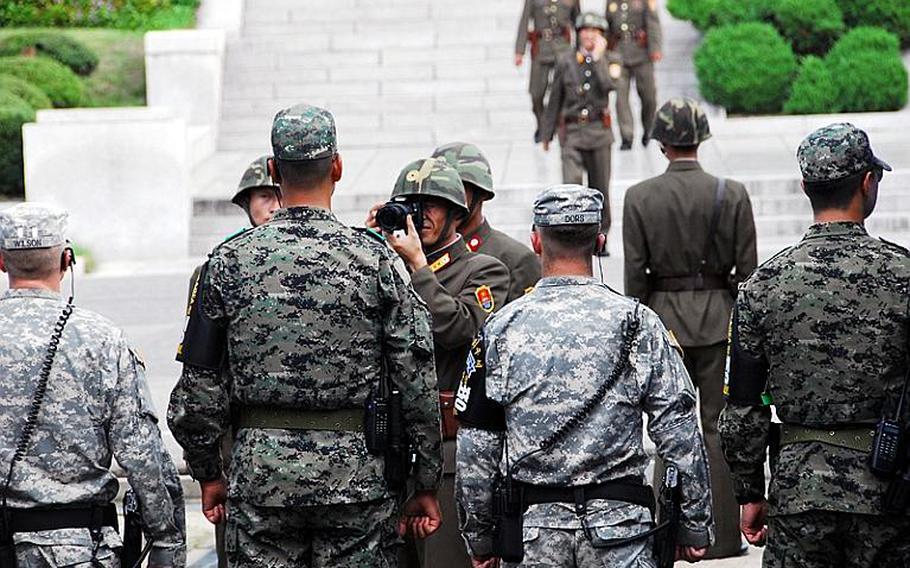Asia-Pacific
N. Korea threat to declare armistice invalid concerns USFK commander
Stars and Stripes March 6, 2013

A North Korean soldier takes a close-up photo of U.S. and South Korean soldiers lined up on the opposite side of the Military Demarcation Line dividing the two Koreas July 27, 2012. The allied soldiers were preparing to protect U.S. Forces Korea commander Gen. James Thurman and other dignitaries who were about to pose for photos of their own after a ceremony marking the 59th anniversary of the armistice that effectively ended the Korean War. (Jon Rabiroff/Stars and Stripes)
SEOUL — The commander of U.S. Forces Korea said Thursday he is concerned about North Korea’s threat to withdraw from the armistice that ended the Korean War and that he stands ready to defend South Korea.
The restrained statement by Gen. James D. Thurman is a stark contrast to the rhetoric that North Korea has ramped up in recent days — including a threat to turn Seoul and Washington into a “sea of fire” — and is in line with stated U.S. policy to avoid escalating tensions on the peninsula.
“It concerns me when any signatory to a mutual agreement makes a public statement contrary to that agreement,” Gen. James D. Thurman said, speaking in his role as commander of the United Nations Command here.
“As the UNC commander, I am fully charged to fully enforce the conditions of the armistice,” he said, without elaborating.
Technically, North Korea cannot unilateraly void the armistice without the consent of all parties to the agreement, South Korean officials have said. However, that has not stopped North Korea from saying it will no longer consider the armistice valid.
In response to the prospect of tighter U.N. sanctions being imposed against the North for its recent nuclear test, and this month’s joint U.S.-South Korean military exercises, Pyongyang has threatened to carry out “a strike of justice at any target anytime as it pleases without limit” once it considers itself no longer bound by the armistice.
North Korea has long used brinksmanship to gain aid and other concessions from the West. The threat to turn Seoul into a “sea of fire” dates back at least to 1994, and while Pyongyang has improved its missile capacity — demonstrated by launching a satellite into orbit in December — it still remains well short of its target of being able to reach the U.S. mainland, let alone Washington, D.C.
The armistice, signed on July 27, 1953, effectively ended the Korean War, though a peace treaty was never signed and the two Koreas still remain technically at war.
Among other things, the pact provided for the transfer of prisoners of war and creation of the Demilitarized Zone and procedures by which to resolve future disagreements between the two Koreas.
On March 1, the U.S. and South Korean militaries began Foal Eagle, the first of two overlapping joint exercises that annually represent the largest use of allied manpower and equipment here. The second, Key Resolve, begins Monday.
The U.N. Command Military Armistice Commission notified the North Korean military weeks ago about the dates of the exercises, advising -- as it does every year -- that they are defensive in nature and not related to “the current situations on the Korean Peninsula.”
The North Korean army’s “supreme command” responded, in a statement carried by the country’s Korean Central News Agency, that the exercises “cannot be construed otherwise than the most dangerous nuclear war maneuvers targeted against (North Korea), and the most undisguised military provocation to be made by a group of all hues of hostile forces.
“This serious situation clearly indicates that the actions of the U.S., South Korea and other hostile forces to infringe upon the sovereignty of (the North) are now leading to a military offensive for aggression, going beyond the level of outrageous economic ‘sanctions,’” the statement said.
Saying the U.S.-South Korean exercises represent a violation of the armistice, the supreme command went on to say that when the second “war maneuvers” begin Monday, it “will completely declare invalid” that agreement.
In doing so, it said, North Korea will cut off the phone line that connects it to the U.S. and South Korean militaries in the Joint Security Area of the DMZ, and prepare to respond to anything it deems a provocation from the south.
“The U.S. imperialists and their allies should not forget even a moment that they are standing at the crossroads of their life and death,” the statement said.
Thurman’s statement concluded by saying, “The success of the armistice has enabled the Republic of Korea to become a vibrant democracy, and we remain ready to defend the Republic of Korea.”
Last year, during Key Resolve/Foal Eagle, USFK spokeswoman Jennifer Buschick was asked why U.S. officials traditionally do not engage in the same level of rhetoric and hyperbole as North Korea when responding to the bombastic taunts often made by the rogue nation.
“Bellicose rhetoric serves no constructive purpose, does not contribute to stability in the region and is not in the spirit of the armistice,” she said. “Our mission is to maintain peace and stability, and to deter aggression on the Korean peninsula, and if that should fail, we are prepared to fight and win.”